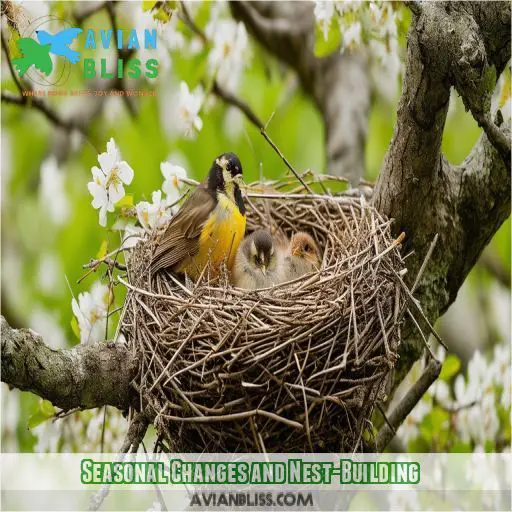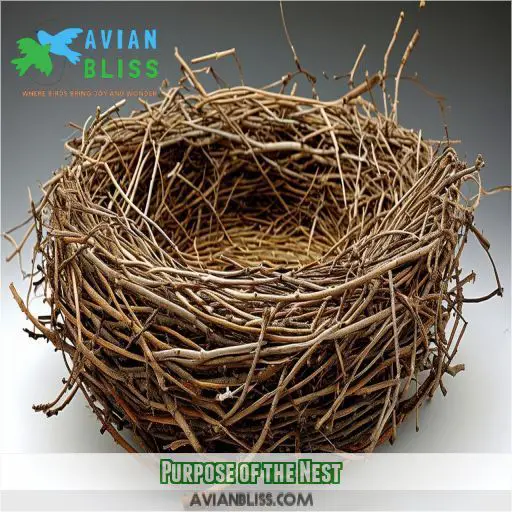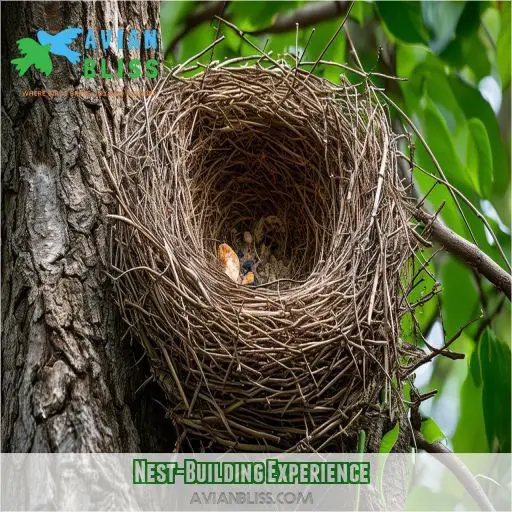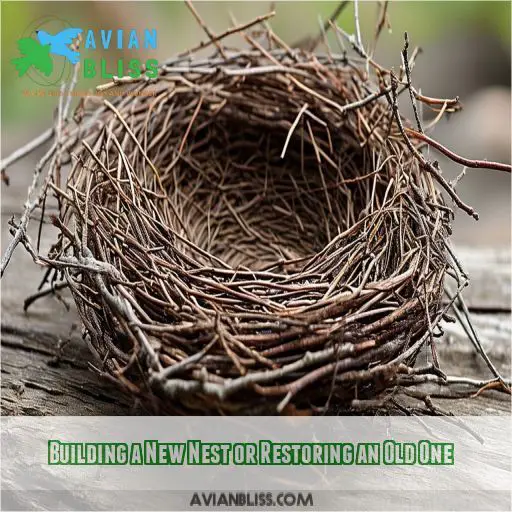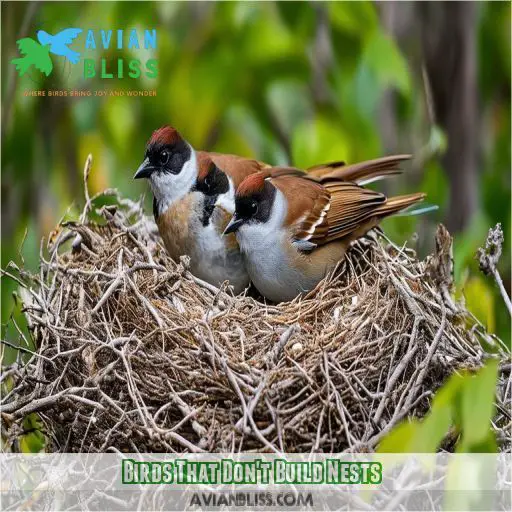This site is supported by our readers. We may earn a commission, at no cost to you, if you purchase through links.
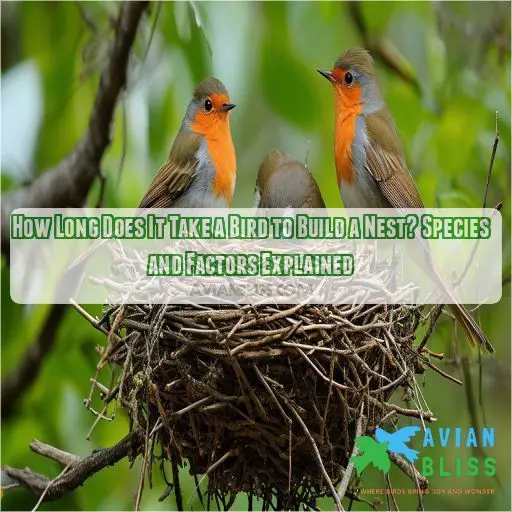
Factors such as nest complexity, weather conditions, and the bird’s experience play important roles. Warmer climates and older birds generally result in faster construction. The nest’s purpose – be it for breeding, courtship, or display – also influences build time.
Curious about which birds are the DIY champions of the avian world?
Table Of Contents
- Key Takeaways
- How Long Does It Take a Bird to Build a Nest?
- Nest-Building Time Varies by Species
- Average Nest-Building Time
- Factors Affecting Nest-Building Time
- Seasonal Changes and Nest-Building
- Purpose of the Nest
- Nest-Building Experience
- Building a New Nest or Restoring an Old One
- Do Males and Females Both Build Nests?
- Birds That Don’t Build Nests
- Frequently Asked Questions (FAQs)
- How long after birds build a nest do they lay eggs?
- Can a bird build a nest in one day?
- How many times will a bird try to build a nest?
- How do birds decide where to build a nest?
- How long is a bird pregnant before laying eggs?
- How long do birds stay in the nest?
- How long does it take a bird to build a nest?
- Do birds build nests?
- How long does it take a bowerbird to build a nest?
- How long does it take to build a house martin nest?
- How long does it take to build a blackbird nest?
- Do birds use the same materials in different regions?
- How do urban environments affect nest-building techniques?
- Can artificial materials harm birds during nest construction?
- Do nocturnal birds build nests differently than diurnal ones?
- How do disabilities or injuries impact a birds nest-building?
- Conclusion
Key Takeaways
- Birds are the real-life Bob the Builders of the animal kingdom, with nest construction times ranging from a speedy 2 days to a marathon 14 weeks. Talk about home improvement on a whole new level!
- It’s not just about slapping some twigs together – factors like nest complexity, weather conditions, and the bird’s experience all play a role in how long it takes to create their feathered fortress.
- Practice makes perfect, even in the avian world. Older birds are like seasoned contractors, whipping up nests faster than their younger counterparts who are still figuring out which end of the twig to use.
- Location, location, location! Birds consider everything from predator safety to food proximity when choosing their nest spot. It’s like house hunting, but with more flapping and fewer mortgage brokers.
How Long Does It Take a Bird to Build a Nest?
Birds typically take between 2 to 14 days to build a nest, though this can vary widely depending on the species and environmental factors. For example, sparrows may complete their nests in just 2 days, while European starlings can take up to 14 weeks to finish their elaborate constructions.
Nest-Building Time Varies by Species
When discussing nest-building time, it’s clear that different bird species have varying timelines. For instance, the American Goldfinch takes about five days to build a nest, while European Starlings can take up to 14 weeks, and Barn Swallows need around two weeks or 21 days.
American Goldfinch: 5 Days
The American Goldfinch takes about 5 days to build its nest. Key construction elements include:
- Nest Complexity: Utilizing dense materials.
- Bird’s Time Investment: Efficient yet detailed.
- Nesting Materials: Thistle, milkweed.
- Structured Building: Secure and hidden location.
House Wren: About a Week
House Wrens typically complete their nests in about a week. They utilize various nest materials like twigs, grasses, and feathers. These nests are often found in cavities, providing a secure location during the nesting season.
European Robin: a Week or So
House Wrens take about a week to build their nests. Similarly, European Robins spend roughly the same amount of time. They carefully select nest materials and locations, making certain their nests are stable and secure.
- Choose twigs and dried grass
- Select a fork in a tree or dense bush
- Build a cup-shaped structure
- Make sure the nest is well-hidden for protection
European Starling: 14 Weeks
European starlings take an impressive 14 weeks to build their nest. They carefully select locations with abundant nest materials, ensuring nest durability to protect their bird eggs throughout the breeding season.
| Aspect | Detail |
|---|---|
| Nest Materials | Twigs, grass, feathers |
| Nest Location | Cavities, buildings, trees |
| Egg Laying Rate | One egg per day |
| Nest Durability | High, typically reused |
Barn Swallow: Two Weeks or 21 Days
Barn swallows build their nests in two weeks, using mud and grass to create a sturdy cup shape. They often choose protected locations such as under eaves or bridges, ensuring:
- Durability
- Protection
- Stability
Average Nest-Building Time
In general, it takes birds between 2 to 14 days to build a nest, with some species like sparrows completing their nests in just 2 days and eastern bluebirds taking about 2-3 days. However, more complex nests or adverse conditions might prolong the process, as seen with the penduline tit and bushtits, which can take over a month.
2. 14 Days on Average
On average, bird nests are built within 2-14 days. Factors like nest materials, nest durability, and nest design can influence this timeframe. Monitoring your local bird’s nest-building process can reveal fascinating details about their nest location and predator defenses.
Penduline Tit and Bushtits: Over a Month
Penduline tit and bushtits can take over a month to build their nests. They create intricate and complex nests from horsehair, twine, and feathers. This lengthy nest-building process guarantees a secure, durable home for their offspring.
Sparrows: 2 Days
For sparrows, it’s impressive to see how quickly they can construct a nest — just 2 days on average! Using a variety of nest materials like twigs and grass, they craft efficient and compact tree nesting structures in dense shrubs or forks of tree branches
.
Eastern Bluebird: 2-3 Days
Eastern Bluebirds typically build nests within 2-3 days. They select cavities in trees or birdhouses, gather nest materials like grass and feathers, and create compact, cup-shaped nests. Monitoring apps and equipment can help track these nesting activities efficiently.
Factors Affecting Nest-Building Time
Nest-building time varies appreciably among bird species, and multiple factors influence the duration. These include nest complexity, seasonal changes, wind, the nest’s purpose, and the bird’s experience.
Nest Complexity
Nest complexity affects time. Materials and design, weather and location, purpose and function vary by species. Some nests combat parasites and competition, while others may be abandoned. Bird behavior often reflects these intricate adaptations.
Seasonal Changes
Seasonal changes impact nesting markedly. Warmer climates allow faster nest-building. In early spring:
- More abundant food sources support rapid construction.
- Higher temperatures boost activity.
- Increased rainfall softens materials, aiding easier manipulation.
Wind
Wind is another critical factor affecting nest-building time. High wind speeds and adverse wind direction can slow construction. Birds often choose locations offering wind protection and consider wind resistance to guarantee nest stability.
| Factor | Influence on Nesting | Bird Consideration |
|---|---|---|
| Wind Speed | Slows construction | Minimal exposure to strong winds |
| Wind Direction | Affects stability | Favorable orientation |
| Wind Resistance | Ensures durability | Use of resilient materials |
Purpose of Nest
Wind can greatly influence a bird’s nest-building time. The purpose of building a nest varies, affecting its construction time. Birds build nests for:
- Breeding
- Courtship displays
- Protecting their young
These purposes determine the nest materials and design.
Nest-building Experience
Effective nest construction skills often develop with age and experience. Environmental influences, like wind and habitat availability, impact nest-building time. Older birds, more adept at material gathering, typically construct nests faster, showcasing efficiency.
Seasonal Changes and Nest-Building
In warmer climates, nest-building progresses more quickly due to favorable weather conditions. Additionally, resident birds, being locally acclimated, tend to start nesting earlier than migratory birds.
Warmer Climates Allow for Quicker Nest-building
Warmer climates play a pivotal role in nest-building for birds. In such environments, you will notice faster nest construction due to favorable conditions like climate variation, which reduces material wear and tear.
Nest adaptation is also easier as available resources are more accessible. Additionally, nest availability and longevity improve since fewer adverse weather conditions exist to damage or destroy nests.
Resident Birds Begin Nesting Earlier Than Migratory Birds
You’ll notice resident birds start their nesting rituals earlier than their migratory counterparts. These year-round inhabitants have a head start in choosing prime nest locations and gathering the best materials. They’re already defending their territories while migrants are still en route.
This early advantage can boost nest success rates, as residents have more time to refine their nest-building skills and prepare for potential predators.
However, early nesters also face challenges like fluctuating spring temperatures, which can impact their carefully timed efforts. It’s nature’s way of balancing the odds.
Purpose of the Nest
Birds build nests for various purposes, including breeding, courtship, and display. The purpose of the nest can affect how long it takes to build, with breeding nests typically requiring more time and effort than those used solely for courtship or display.
Breeding
As you’ve seen, seasonal changes influence nest-building. Now, let’s focus on breeding. When birds construct nests for breeding, they carefully select materials and locations. The nest’s size and shape are essential for protecting eggs and nestlings. Nest lifespan varies, but it’s typically designed to last through one breeding cycle. You’ll find birds ingeniously adapting their nests to guarantee successful reproduction.
Courtship
You’ll find that courtship plays a pivotal role in nest-building. Birds use their nests to attract mates during this phase. Timing of breeding affects nest location and construction. Courtship songs often accompany the process, with males showcasing their skills.
Here are three key aspects of courtship nest-building:
- Material selection
- Strategic placement
- Architectural complexity
Display
Beyond courtship, some birds build nests purely for display. These structures showcase the builder’s skill and can attract potential mates. Let’s explore how display nests differ from functional ones:
| Feature | Display Nest | Functional Nest |
|---|---|---|
| Size | Often larger | Practical |
| Shape | Elaborate | Simple |
| Durability | Less important | Critical |
Maintenance and concealment are less essential for display nests, as their primary purpose is to impress.
Nest-Building Experience
You’ll find that older, more experienced birds can construct nests faster than their younger counterparts. This efficiency comes from practice and familiarity with the process, allowing seasoned builders to complete their nests more quickly and with greater skill.
Older Birds Build Nests Faster
You’ll find that older birds are the master architects of the avian world. Their nest-building skills improve with each season, allowing them to construct homes faster and more efficiently.
Nest complexity varies by species, but experienced birds tackle challenges with ease. They’ve learned to adapt to seasonal effects and work around environmental obstacles.
Male and female roles in nest-building differ among species, but seasoned pairs often collaborate seamlessly.
These feathered veterans know the best materials and techniques, turning what could be a lengthy process into a swift and precise operation.
Inexperienced Birds May Take Longer
You’ll notice that inexperienced birds often struggle with nest-building. They’re like first-time homeowners, fumbling with unfamiliar tools and materials.
These novice builders may take longer to gather the right nest-building materials or perfect their building techniques. They might face challenges in selecting ideal locations or constructing sturdy structures.
As they learn, their nest-building strategies improve, but the duration can be frustratingly long at first. It’s a trial-and-error process, where each attempt hones their skills.
Eventually, these feathered apprentices become master architects, reducing their nest-building time noticeably.
Building a New Nest or Restoring an Old One
You’ll find that most birds don’t reuse their old nests, opting instead to build fresh ones each breeding season. However, some species may construct new nests on top of old ones, incorporating the previous structure into their updated dwelling.
Birds Typically Do Not Reuse Old Nests
You might think birds would save time by reusing old nests, but that’s not typically the case. Nest longevity is limited, and most birds opt for fresh construction each season. Here’s why:
- Parasite prevention: Old nests can harbor harmful parasites.
- Structural integrity: Weather-worn nests may not be safe for new broods.
- Predator avoidance: Reusing nests increases the risk of predator detection.
Seasonal nest reuse patterns vary, with some species showing exceptions. Nest site competition also plays a role, as prime locations are often contested. While building anew takes effort, it’s usually the safest bet for our feathered friends.
Some Birds May Build on Top of Old Nests
While most birds build new nests each season, some species aren’t afraid to get creative with fixer-uppers. You’ll find that certain birds, like robins and phoebes, might renovate abandoned nests. They’ll spruce up old structures with fresh materials, saving time and energy.
This nest reuse pattern depends on the durability of existing nests. Bigger birds, such as eagles and ospreys, often return to their sturdy nests year after year, adding new layers. It’s like they’re constantly renovating their high-rise apartments!
Do Males and Females Both Build Nests?
While some birds build solo, many species team up for nest construction. You’ll often find both males and females pitching in, showcasing a fascinating display of avian teamwork. This cooperation varies among species, reflecting diverse gender roles in the bird world.
- Male cardinals gather materials while females weave
- Barn swallows work side-by-side, mud-gathering and shaping
- Male bowerbirds construct elaborate display nests to attract mates
- Female hummingbirds take on full nest-building responsibility
The sexual division of labor in nest-building can be complex. Some males contribute materials, while females do the construction. In other species, roles are more balanced. This collaboration often extends to parental care, with both parents investing in their future offspring’s home.
Birds That Don’t Build Nests
While most birds build their own nests, some species have evolved alternative strategies. House sparrows are known to steal nests from other birds, while cowbirds practice brood parasitism by laying their eggs in the nests of unsuspecting host species.
House Sparrows: Steal Nests From Other Birds
While most birds build their own nests, house sparrows have a different approach. These feathered opportunists engage in nest piracy, stealing homes from other birds. You’ll often find them muscling in on nests built by bluebirds, swallows, or martins. Here’s a breakdown of their nesting behavior:
| Behavior | Description | Impact |
|---|---|---|
| Stealing | Forcibly take over nests | Displaces native birds |
| Squatting | Occupy empty nests | Reduces nesting sites |
| Competing | Aggressively defend stolen nests | Increases nest abandonment |
| Modifying | Adapt nests to their needs | Alters habitat dynamics |
| Multiplying | Rapid reproduction in stolen nests | Amplifies competition |
Cowbirds: Brood Parasites, Lay Eggs in Other Birds’ Nests
Unlike house sparrows, cowbirds take a different approach to nesting. As brood parasites, they’ve mastered the art of outsourcing parental duties. You’ll find these clever birds laying their eggs in other species’ nests, leaving the unsuspecting hosts to raise their young. Here’s what you need to know about cowbirds:
- They don’t build nests at all
- Females can lay up to 40 eggs per season
- Host birds often can’t distinguish the parasitic eggs
This strategy allows cowbirds to conserve energy and increase their reproductive success, but it comes at a cost to the host species.
Frequently Asked Questions (FAQs)
How long after birds build a nest do they lay eggs?
You’ll typically see eggs within 1-2 days after nest completion. Some birds lay immediately, while others wait up to a week. It’s a quick turnaround, as they’re keen to start their family!
Can a bird build a nest in one day?
Rome wasn’t built in a day, and neither are most bird nests. While some speedy builders like sparrows can construct a simple nest in 24 hours, it’s rare. Most birds need 2-3 days minimum for a functional home.
How many times will a bird try to build a nest?
You’ll find birds are persistent nest-builders. They’ll typically attempt 3-5 times if disturbed or unsuccessful. Some species may try up to 12 times in a season. Weather, predators, and resource availability influence their persistence.
How do birds decide where to build a nest?
You might think birds choose nesting spots randomly, but they’re quite selective. They’ll consider safety from predators, proximity to food sources, and protection from harsh weather. Instinct guides them to seek out secluded, sturdy locations that’ll support their offspring’s survival.
How long is a bird pregnant before laying eggs?
You’ll find that birds aren’t pregnant like mammals. Instead, they develop eggs internally for about 24 hours before laying. After that, they’ll incubate the eggs for 10-30 days, depending on the species.
How long do birds stay in the nest?
Birds typically stay in the nest for 10-18 days after hatching. You’ll notice this nestling period varies by species. Smaller birds fledge quicker, while larger ones need more time to develop before taking their first flight.
How long does it take a bird to build a nest?
You’ll find that nest-building time varies widely among birds. It typically takes 2-14 days, depending on the species, weather, and material availability. Some birds, like sparrows, finish in 2 days, while others, like European starlings, can take weeks.
Do birds build nests?
Yes, most birds build nests. You’ll find them crafting intricate structures from twigs, grass, and leaves. They’re nature’s architects, creating homes for their eggs and chicks. It’s an essential part of their breeding cycle.
How long does it take a bowerbird to build a nest?
You’ll be surprised to learn that bowerbirds don’t actually build nests! Instead, they construct elaborate bowers to attract mates. These intricate structures can take up to two months to complete, showcasing the male’s dedication and artistry.
How long does it take to build a house martin nest?
You’ll find house martins are diligent builders, taking 7-14 days to construct their nests. They’re careful, using mud pellets mixed with saliva. Weather conditions and material availability can influence the timeline, so don’t be surprised if it varies.
How long does it take to build a blackbird nest?
You’ll find blackbirds typically spend 3-4 days constructing their nests. They’re efficient builders, weaving twigs, grass, and mud into a sturdy cup shape. Factors like weather and material availability can slightly alter this timeframe.
Do birds use the same materials in different regions?
Beaks build based on bounty. You’ll find feathered friends fashioning nests from locally available materials. In urban areas, they’ll use string or paper, while rural birds might opt for twigs, grass, and leaves. Adaptability’s their forte in nest construction.
How do urban environments affect nest-building techniques?
Urban environments challenge birds’ nest-building techniques. You’ll notice they adapt by using man-made materials like string, plastic, or wire. They’ll often choose unconventional locations, such as ledges or air conditioners, to compensate for fewer trees and natural spaces.
Can artificial materials harm birds during nest construction?
Hold your horses, urban cowboy! Artificial materials can indeed harm birds during nest construction. You’ll find they may ingest or become entangled in plastics, string, or wire. It’s best to provide natural nesting materials in your yard.
Do nocturnal birds build nests differently than diurnal ones?
You’ll find nocturnal birds often build nests differently than diurnal ones. They typically choose secluded spots like dense foliage or tree cavities. Their nests are usually simpler, with less elaborate construction, as they prioritize concealment over intricate design.
How do disabilities or injuries impact a birds nest-building?
Disabilities or injuries can noticeably hinder a bird’s nest-building abilities. You’ll notice they may struggle with material gathering, construction precision, and overall nest stability. These challenges often lead to slower building processes and potentially less secure homes for their offspring.
Conclusion
Like a feathered architect, each bird species approaches nest-building with its own timeline and techniques. You’ve learned that the time it takes a bird to build a nest can range from a mere 2 days to a staggering 14 weeks.
Factors like nest complexity, weather, and experience all play important roles. Whether it’s for breeding, courtship, or display, the purpose of the nest also influences construction time.




